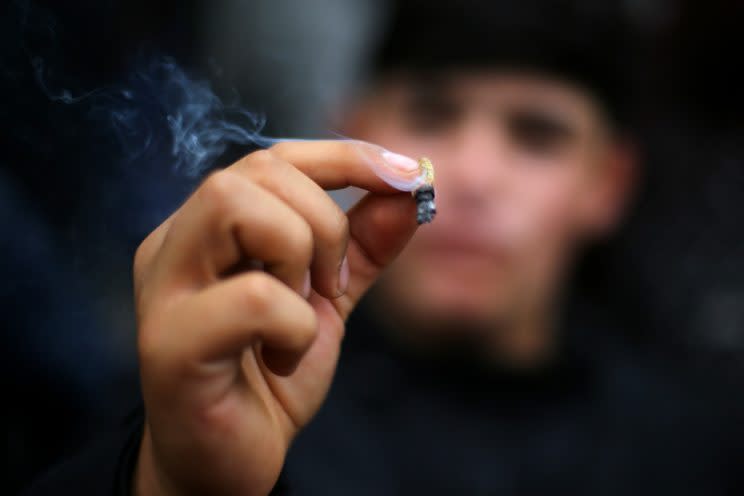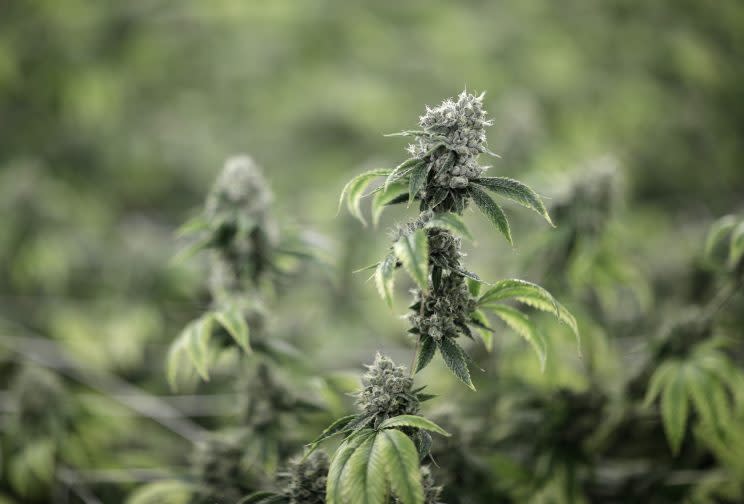No one has ever died from a pot overdose, but the DEA is taking no chances

The Drug Enforcement Administration (DEA) admits that no one ha-s ever died from a marijuana overdose but still won’t remove the substance from its list of Schedule I drugs — the same classification as heroin.
“No deaths from overdose of marijuana have been reported,” the DEA wrote in its 2017 Drugs of Abuse resource guide, which was published last month. The 2015 edition has similar language.
For context, roughly 2,200 people die from alcohol poisoning each year in the United States — six per day.
Despite its relative safety, marijuana remains one of the most strictly prohibited drugs in the country under federal law, even as increasing numbers of states have moved toward legalization. The Food and Drug Administration (FDA) and DEA classify it as a Schedule I substance, meaning there’s a “high potential for abuse,” no currently “accepted medical use in treatment” and “a lack of accepted safety for use under medical supervision.”
Michele Leonhart, the former head of the DEA, infamously refused to say whether heroin is worse than marijuana for someone’s health while testifying before Congress in June 2012. She would dodge the question by simply saying, “I believe all illegal drugs are bad.”
For the record, heroin is far more harmful than marijuana. The Centers for Disease Control and Prevention reports that overdose deaths from heroin in the U.S. have more than quadrupled since 2010 — killing nearly 13,000 in 2015. Opioid addiction is by some accounts the country’s most urgent public health crisis.

Schedule I drug
Acting DEA Administrator Chuck Rosenberg wrote a letter rejecting petitions for rescheduling marijuana in August 2016. In the letter, he conceded that marijuana is “less dangerous than some substances in other schedules” and that this “strikes some people as odd.” (It does strike many as odd that cocaine, for instance, is a Schedule II substance because of its potential as a topical anesthetic.)
But Rosenberg said the criteria for pot’s inclusion in Schedule I is not its “relative danger.”
“In that sense, drug scheduling is unlike the Saffir-Simpson scale or the Richter scale,” Rosenberg wrote. “Movement up those two scales indicates increasing severity and damage (for hurricanes and earthquakes, respectively); not so with drug scheduling. It is best not to think of drug scheduling as an escalating ‘danger’ scale – rather, specific statutory criteria (based on medical and scientific evidence) determine into which schedule a substance is placed.”
A spokesperson for DEA told Yahoo News that “judicial precedent” established a five-part test to determine whether marijuana has a “currently accepted medical use in treatment,” serving as a differentiating factor between Schedule I and II.
The five parts are as follows: the drug’s chemistry is known and reproducible, there are adequate safety studies, there are adequate and well-controlled studies proving efficacy, the drug is accepted by qualified experts and the scientific evidence is widely available.

Legal medical marijuana’s relationship to the opioid epidemic
As attitudes toward marijuana change in the U.S., the backlash to its strict classification at the federal level is growing. Critics of current marijuana laws argue that the pharmaceutical industry’s greed and government bureaucracy have undermined research that would allow the substance to help fight the opioid epidemic.
Rather than being a gateway drug to harder substances, as health-education classes have taught for decades, preliminary studies suggest that legal medication marijuana might be associated with fewer opioid prescriptions and overdoses. Even the National Institute on Drug Abuse recognizes this correlation, although more evidence is still needed to confirm the finding.
A study from November 2015, for instance, titled “Do Medical Marijuana Laws Reduce Addiction and Deaths Related to Pain Killers?” found that legal protection for medical marijuana dispensaries was correlated with fewer opioid prescriptions, instances of opioid-abuse and admissions into opioid addiction treatment programs.
Pharmaceutical companies that sell opioids have been lobbying to keep medical marijuana illegal. Not coincidentally, legal medical marijuana cuts into their sales.
W. David and Ashley Bradford, a father-daughter pair of public policy researchers at the University of Georgia, conducted two studies on the frequency of prescriptions for various drugs between states with or without legalized medical marijuana. They looked at drugs for anxiety, depression, glaucoma, nausea, psychosis, seizures, sleep disorders, spasticity and pain.
“What we found was that when states turned on medical marijuana laws, the prescribing for pain medications fell enormously, by about 1,800 daily doses per doctor per year. That’s very significant statistically,” W. David Bradford told Yahoo News.

In 2013, states with medical marijuana saved the U.S. government about $165 million in Medicare payments for all nine categories of drugs. They calculated that if all states had medical marijuana, Medicare would have spent about $468 million less.
Since that paper came out, the Bradfords gathered two additional years of data and redid their analysis, paying attention to whether states used dispensaries. The article with their new findings is under review for publication.
“If states had turned on dispensary-based medical marijuana laws in 2015, Medicare could’ve saved about $1.7 billion,” he said. “That’s a big reduction in use. And that’s all pain medication. About 30-40 percent of that is opiates.”
Government hurdles to research
Small-scale observational studies suggest that marijuana has therapeutic value in a medical context. However, the FDA requires large-scale clinical trials involving thousands of human participants to confirm its benefits and harms before removing it from Schedule I.
For years, advocates for marijuana legalization said they faced a Catch-22: the federal government’s strict regulation of marijuana prevented the very research the government required to demonstrate that it shouldn’t be regulated so strictly.
An October 2015 report from the Brookings Institution, a nonpartisan think tank in Washington, D.C., titled “Ending the U.S. government’s war on medical marijuana research,” corroborated that statutory, regulatory, bureaucratic and cultural barriers are stifling scientific research on the substance.

“It is time for the federal government to recognize the serious public policy risks born from limited medical, public health, and pharmaceutical research into cannabis and its use,” wrote John Hudak and Grace Wallack, the study’s authors.
Simply put, the federal government’s restrictions have held the scientific community back and forced doctors and patients to operate on a “learn-as-you go” basis.
In August 2016, the DEA removed a major barrier by announcing it would expand the number of places permitted to grow medical marijuana to test its potential beneficial purposes.
Morgan Fox, a spokesperson for the Marijuana Policy Project, a pro-legalization nonprofit, would like marijuana to be removed from the schedule altogether and treated like alcohol at the federal level.
“It is good to see that the DEA is making an attempt at scientific legitimacy instead of using its traditional fear tactics. Hopefully it will contribute to an honest, realistic conversation on drug policy going forward,” Fox told Yahoo News.

The war on drug’s dubious legacy
A study from the Human Rights Watch and the American Civil Liberties Union found that arrests for possessing small amounts of marijuana for personal use exceeded arrests for all violent crimes in 2015. According to the report, African-American adults smoke pot at similar rates to their white counterparts but are nearly four times more likely to be arrested for possessing the drug.
According to the Drug Policy Alliance, which promotes drug policies founded in science and human rights, the U.S. spends more than $5 billion per year in the “war on drugs.” Over the past four decades, the U.S. government has spent over $1 trillion to fight drugs. Judging from the current heroin epidemic, this strategy has been of little help other than swelling the size of the country’s prison population, which is the largest in the world.
Sam Harris, a neuroscientist and philosopher who opposes the war on drugs, says that it never should have been waged in the first place.
“I can think of no right more fundamental than the right to peacefully steward the contents of one’s own consciousness,” he said on his “Waking Up” podcast. “The fact that we pointlessly ruin the lives of nonviolent drug users by incarcerating them, at enormous expense, constitutes one of the great moral failures of our time.”
Read more from Yahoo News:
Trump’s Paris trip is poised to give a clear win to France’s Macron
Even some in White House are frustrated by the stonewalling on Donald Jr.’s meeting
White House launches preemptive strike on CBO, anticipating report on health care bill
Photos: In Mosul, the war is never over, even when the shooting stops


